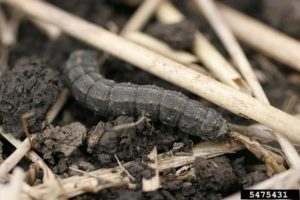Mar 22, 2022Beware of cutworm issues in high tunnel crops
As growers prepare to get their high tunnels going, University of Minnesota Extension is sharing information on how to find and identify cutworms.
We often hear from growers in the summer about cutworm issues in high tunnel crops, oftentimes long after the damage has been done. It is always hard to retrace the steps and figure out what caused the damage. As we get ready to think about starting transplants and getting high tunnels going, now is the time to think about past cutworm problems so we can hopefully catch the culprits and work on the problem in the future.
Who are the cutworms?
“Cutworms” is a label that applies broadly to a large group of caterpillars with a wide range of life histories. Some of the insects live in Minnesota year-round, while others migrate on weather fronts. There are approximately 10 different cutworms and armyworms species we see in Minnesota that could cause the damage people report. The fact that cutworm applies to caterpillars that cause a type of damage (eating transplant and young plants, often by snipping them off the base) rather than insects with a similar biology (in terms of when eggs are laid, where they spend the winter, what they eat, etc.) makes it hard to prescribe management recommendations based on seeing cutworm damage alone.
Making this more complicated is that caterpillars that feed in this way often hide out in the day and do their damage at night. This makes it harder to see the caterpillar culprit, again complicating figuring out who is doing the damage, making it harder to manage.
How do I find them?
Cutworm caterpillars are active at night. To find them, you can scout at dawn or dusk. If you find damage, try digging around the snipped plants – caterpillars hide in the top few inches of the soil.
Who are our suspects?
Winter Cutworm
One of the most cold-hardy and early emerging cutworms we see in Minnesota is aptly called Winter Cutworm. The adult form is a distinctive moth, the large yellow underwing.
Unfortunately, the caterpillars that do the damage are much less distinctive. They can be a variety of colors, and can be identified by looking for dark dashes running down their bodies.


They become active when temperatures are over 40°F, people sometimes report seeing them crawling on the snow.
These caterpillars love to eat grasses, and can build up their populations over the year in the grassy areas around high tunnels. If these grasses are mowed, the cutworms can move to other areas where there are tender, living plants. They have been recorded feeding on a wide variety of vegetables.
Black Cutworm
As opposed to winter cutworms, where every life stage survives in Minnesota all year, black cutworm does not survive Minnesota winters. The adult moths are carried to Minnesota on south to north airflow, with stormfronts potentially depositing moths in our area. These conditions don’t happen every spring, and some years have very little black cutworm pressure. These moths lay eggs on anything green, and caterpillars will feed on a large variety of plants. If these plants are mowed, tilled, or otherwise disturbed, they will move onto other green, tender plants. This could lead them to the crops we grow in high tunnels.


Other suspects
Sometimes it feels like you can just add an adjective to the word cutworm and you have a species. In Minnesota alone, we have variegated cutworm, dingy cutworm, bronzed cutworm, glassy cutworm, and more. Each of these species could be behind the damage we see in Minnesota high tunnels, though without catching caterpillars to do ID, it is impossible to say what to do about them.
Snails and rodents can also cause damage people sometimes attribute to cutworms.
What cutworms are we seeing in Minnesota high tunnels? We need your help to figure it out!
The two pictures above highlight how generic different cutworm caterpillars can be. If you are seeing damage, please reach out so we can investigate and get the caterpillar located and identified. Once we know who is causing the problem, we can get better recommendations for dealing with these early season pests, especially in high value high tunnels.
Please reach out to Marissa Schuh ([email protected], 612.460.7462) to work on scouting plans, diagnosis and management options.
– University of Minnesota Extension















